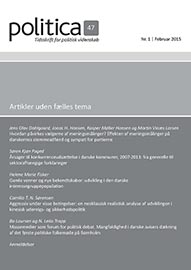Hvordan påvirkes vælgerne af meningsmålinger? Effekten af meningsmålinger på danskernes stemmeadfærd og sympati for partierne
DOI:
https://doi.org/10.7146/politica.v47i1.131474Abstract
Som al anden information kan meningsmålinger påvirke opinionen. Vi præsenterer to hypoteser til at forstå, hvordan meningsmålinger påvirker opinionen: bandwagon- og underdog-effekten. Bandwagon-effekten hævder, at vælgerne “springer med på vognen”, således at et parti i fremgang vil opleve yderligere tilslutning og omvendt, hvis partiet står til tilbagegang. Underdog-effekten fremhæver, at et parti, som står til tilbagegang, høster sympatistemmer. De to hypoteser testes via et survey-eksperiment. Vi finder belæg for bandwagon-effekten, og effekten er stærkest i positiv retning: Når et parti går frem, trækker det flere med. Der er også tendens til den negative bandwagon-effekt. Der findes ikke belæg for underdog-effekten. Effekterne er i samme retning uafhængigt af partiets størrelse. Vi afslutter med at diskutere forbud mod offentliggørelse af meningsmålinger.
References
Alvarez, R. Michael, Frederick J. Boehmke og Jonathan Nagler (2006). Strategic voting in British elections. Electoral Studies 25 (1): 1-19.
Ansolabehere, Stephen og Shanto Iyengar (1994). Of horseshoes and horse races: Experimental studies of the impact of poll results on electoral behavior. Political Communication 11 (4): 413-430.
Bolvinkel, Morten (2014). Uventet melding fra S: Stem på Bendt Bendtsen. TV2, 5. maj.
Brady, Henry og John Mcnulty (2011). Turning out to vote: The costs of finding and getting to the polling place. American Political Science Review 105 (1): 115-134.
Ceci, Stephen J og Edward L. Kain (1982). Jumping on the bandwagon with the underdog: The impact of attitude polls on polling behavior. Public Opinion Quarterly 46 (2): 228-242.
Dahlgaard, Jens Olav, Jonas Hedegaard Hansen, Kasper Møller Hansen og Martin Vinæs Larsen (2014). Hvordan påvirkes vælgerne af meningsmålinger?: Rapport om effekten af meningsmålinger på danskernes stemmeadfærd og sympati for partierne. København: Institut for Statskundskab, Københavns Universitet.
Daschmann, Gregor (2000). Vox pop & polls: the impact of poll results and voter statements in the media on the perception of a climate of opinion. International Journal of Public Opinion Research 12 (2): 160-181.
Donsbach, Wolfgang (2001). Who’s Afraid of Election Polls?: Normative and Empirical Arguments for the Freedom of Pre-election Surveys. Amsterdam: Foundation for Information.
Erikson, Robert S. og Laura Stoker (2011). Caught in the draft: The effects of Vietnam draft lottery status on political attitudes. American Political Science Review 105 (2): 221-237.
Gallup, George og Saul Forbes Rae (1940). Is there a bandwagon vote? Public Opinion Quarterly 4 (2): 244-249.
Gerber, Alan S, Gregory A. Huber, David Doherty og Conor M. Dowling (2011). The big five personality traits in the political arena. Annual Review of Political Science 14: 265-287.
Hansen, Kasper Møller (2014). Mediernes meningsmålinger, pp. 119-132 i Kasper Møller Hansen og Karina Kosiara-Pedersen (red.), Folketingsvalgkampen 2011 i perspektiv. København: DJØF forlag.
Hardmeier, Sibylle (2008). The effects of published polls on citizens, pp. 504-513 i The SAGE Handbook of Public Opinion Research. Los Angeles: Sage.
Irwin, Galen A. og Joop J. Van Holsteyn (2008). What are they waiting for? Strategic information for late deciding voters. International Journal of Public Opinion Research 20 (4): 483-493.
Lau, Richard R. og David P. Redlawsk (2001). Advantages and disadvantages of cognitive heuristics in political decision making. American Journal of Political Science 45 (4): 951-971.
Leibenstein, Harvey (1950). Bandwagon, snob, and Veblen effects in the theory of consumers’ demand. The Quarterly Journal of Economics 64 (2): 183-207.
Michniewicz, Kenneth S. og Joseph A. Vandello (2013). The attractive underdog. When disadvantage bolsters attractiveness. Journal of Social and Personal Relationships 30 (7): 942-952.
Mondak, Jeffery J. (2010). Personality and the Foundations of Political Behavior. Cambridge: Cambridge University Press.
Moy, Patricia og Eike Mark Rinke (2012). Attitudinal and behavioral consequences of published opinion polls, pp. 225-245 i Christina Holtz-Bacha og Jesper Strömbäck (red.), Opinion Polls and the Media: Reflecting and Shaping Public Opinion. Basingstoke: Palgrave Macmillan.
Pedersen, Rasmus Tue (2014). News media framing of negative campaigning. Mass Communication and Society 17 (6): 898-919.
Pettit, Nathan C., Niro Sivanathan, Eric Gladstone og Jennifer Carson Marr (2013). Rising stars and sinking ships consequences of status momentum. Psychological Science 24 (8): 1579-1584.
Restrepo, Juan M., Rosalyn C. Rael og James M. Hyman (2009). Modeling the influence of polls on elections: a population dynamics approach. Public Choice 140 (3-4): 395-420.
Sandvik, Siv, Ellen Viseth, Cato Fossen og Rolf Jakobsen (2013). Krisemåling kaster Lysbakken ut av tinget. NRK, 16. august.
Simon, Herbert A. (1954). Bandwagon and underdog effects and the possibility of election predictions. Public Opinion Quarterly 18 (3): 245-253.
Stubager, Rune, Kasper Møller Hansen og Jørgen Goul Andersen (2013). Krisevalg. Økonomien og Folketingsvalget 2011. København: DJØF forlag.
Aalberg, Toril og Peter Van Aelst (2014). Who is afraid of preelection polls? How perceptions of polls influence support for polling regulations among elites. International Journal of Public Opinion Research 26 (4): 517-530.





